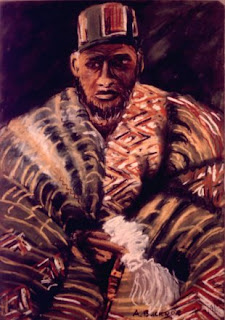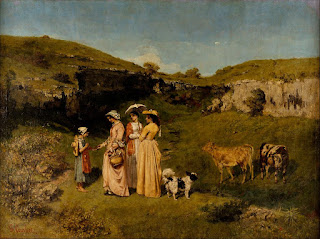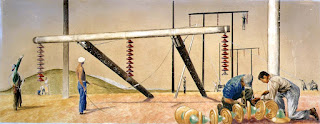The mid-Modern Era of art introduced the world to a wide variety of different types of art that emerged from all across the globe. Following the end of the Second World War, different art styles emerged, and as a result, increased the diversity in the types of art styles, the artists who introduced these new and unique art styles, and the degree to which newer forms of art are to be perceived and appreciated. The diversity of the art styles that were developed during this era are sometimes hard to explain. Such art styles contributed to the growth of art globally. We will now examine some of the more notable artists of the Mid-modern era, and the different styles that were exhibited in their artwork, and the diversity that it brought to world of art during this era.
Blaze 1 by Bridget Riley, 1962, London
Movement in Squares by Bridget Riley, 1961, London
Among the memorable art styles that appeared on the public scene during the Mid-modern era is the art style that is known as optical art, or opt art for short. Optical art deals with how the eye perceives objects/things that are presented. This style art allows viewers the diversity in the perception of an object, and the interpretation of what is being presented to the observer. British artist Bridget Riley is one of the prominent names who's associated with works of optical art during the Mid-modern era. Two of her works: Movement in Squares & Blaze 1 demonstrate Riley's unique experimentation with optical art. There's no denying the beauty and diversity that's illustrated within these two pieces of art. In Riley's Blaze 1, our eyes remain glued to the unique of spherical geometric shape that is created from curved lines, which consist of bent lines within those curves. Yet, as the curved lines become smaller and smaller as we look inward, we can see the high-contrast value of the sphere, as different tonal images appear within the curved lines. But when we examined Riley's other piece of artwork: Movement in Squares, such isn't the case. There's a clear low-contrast value between the black-and-white colored checkered design layout. There's only black & white color, and only square and rectangular geometric shapes. Nevertheless, the differences within these works of art by Riley demonstrate to us impact of diversity within the world of optical art, as well in the world of art altogether. With regards to placement, I would argue that I would like to have these designs on the flooring of my home, or in the case of Blaze 1, is something that I'd like to have on the wall of my home. Nevertheless, the emotions that I get when looking at optical art work such as these ones produced by Bridget Riley are of boredom & apathy. I think they make good decorations in restaurant floor tiles and the like. But I really don't get too excited for optical artwork of this nature.
Blue Monday Strip by Rebecca Horn, 1993, Guggenheim Museum, New York City
Paradiso by Rebecca Horn, 1993, Guggenheim Museum, New York City
Another style that arose from the Mid-modern era is the style of conceptional art. Some examples of this style include the works done by German artist Rebecca Horn. Among Rebecca Horn's notable artworks that demonstrate the diversity that's exhibited within this conceptual art form are Blue Monday Strip & Paradiso (shown above). In Horn's Paradiso exhibit, we can get a glimpse of the idea behind the art. In this exhibit, Horn uses several objects such as two "swollen, breast-like funnels that are suspended high above the museum's rotunda" (Guggenheim Foundation). It's important to note here that much of Horn's works "were fraught with sexual allusion & the ache of desire" (Guggenheim Foundation) Looking at this exhibit, we can sense the idea/purpose behind it. This is somewhat the goal of conceptual art. It's not so much about what is presented, but the idea behind it. As a result, this art style sets itself apart from many of the other art styles that bound by specific rules and customs, make it among the more diverse styles that is currently present. Looking at both Blue Monday Strip and Paradiso, we can see the geometric shapes of the objects that are being displayed, as well as the geometric shapes that are created by the straight lines, curved lines, and diagonal lines that are connected together via intersection by design. Both displays consist of the same amount of light colors, whereas in Paradiso, Horn does an interesting job of using dark color in random areas of the exhibit. Looking at these works by Horn, I get the sense of being in a place that is calm and worth exploring. I feel like this is something that's worth decorating my home for. The emotions that come to mind when I observe these works by Rebecca Horn are of poise, calmness, and relaxation. It's certainly a place where I'd like to be!
James, by Chuck Close, 2002, San Francisco
Self Portrait (Yellow-Jacket), by Chuck Close, 2013, San Francisco
Lastly, one cannot ignore the diversity within the Mid-modern era that led to creation of a particular style known as photorealism. Photorealism was a style of art that rejected abstractionism that emerged in the 1960's that centered around artists taking photographs, and then using them to perform their artwork. Chuck Close was one of the artists who took up the style of art. Among his photorealism works include James and Self-Portrait (Yellow-Jacket). Thanks to the growing diversity during the mid-Modern Era, styles such as photorealism allowed more artists to highlight the detail that they were trying to show to observers of their work. In both James & in Self-Portrait, Close gives us the opportunity to see the fine details of his work. Such details include the organic shapes of the figures involved, as well as the curved lines that are noticeable on the subjects in the images. The use of dark and light colors adds a layer of realism to the artwork. But in terms of placement, these works of art by Chuck Close would be best served by being hung around the personal residence of an individual, or in a personal space/quarter. But the emotions that I feel when I observe these works by Close are that of apathy. I do believe, however, that photorealism artwork is worth promoting and celebrating from a cultural perspective, especially with regards to diversity in the world of art.
References:-
https://www.sfmoma.org/artwork/2014.801/
https://www.guggenheim.org/artwork/1688









Comments
Post a Comment